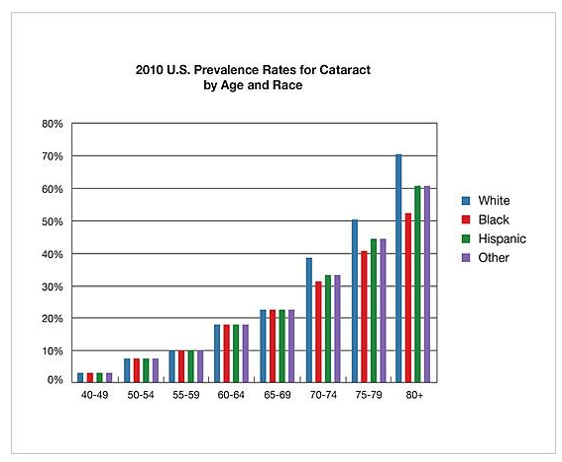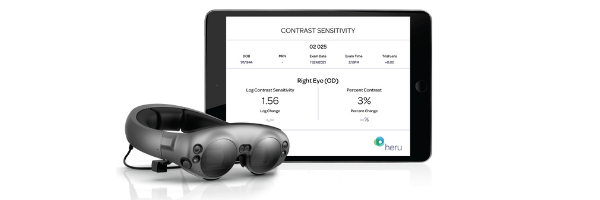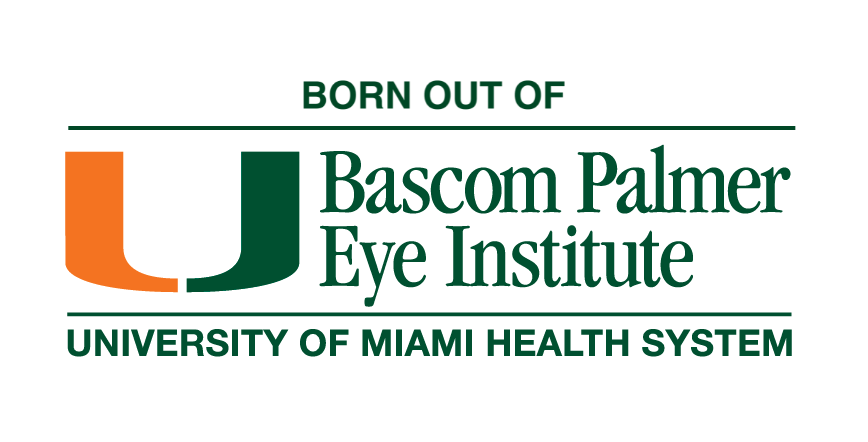A top concern for many patients over age 60 is age-related cataracts (a progressive eye condition that can negatively impact a patient’s quality of life).
With each decade of life, the prevalence of age-related cataracts increases. Its earliest signs and symptoms start to show around age 40. According to data from the National Eye Institute, by age 75, half of white Americans will have cataracts.
The prevalence of cataracts continues to grow.
The number of Americans affected by cataracts is predicted to double by 2050, with the most rapid increase expected among the Hispanic-American community, according to the NIH’s National Eye Institute.1

During your patients’ office visits, they may be sharing signs of cataracts, such as problems with glare, needing more light to read, or having difficulty driving at night. These signs are often linked to a decrease in contrast sensitivity, which usually presents before a decrease in visual acuity.
The effect of cataracts on driving can be especially concerning. Driving is often closely linked to independence in a patient’s mind. A 2020 study identified a correlation between decreased mesopic contrast sensitivity and an increased risk of car crashes among older adults, as reported in BMC Ophthalmology.2
This link underscores the importance of testing for mesopic contrast sensitivity for the health and safety of patients, since glare and mesopic vision can be significantly improved with cataract surgery.
Obtaining a diagnosis as early as possible is crucial since it enables us to provide better patient management and achieve better patient outcomes.

While the Snellen test is great for determining visual acuity, it may not always be successful in identifying cataracts.
A person with posterior subcapsular cataracts, for example, might demonstrate good visual acuity yet have significant problems with glare, which Contrast Sensitivity (CS) testing can help identify. A study in the Journal of Ophthalmic & Vision Research reported a strong correlation between decreased contrast sensitivity and the optical density of cataracts3.
Over the years, the paper chart-based Pelli-Robson test has become well established for measuring CS. More recently, web-based tests, such as SPARCS, have introduced an at-home, self-testing option for patients.
But both the Pelli-Robson and web-based tests present challenges. While inexpensive and easy to use, paper charts fade over time, it can be challenging to ensure proper illumination, and the old-fashioned paper charts may not hold patient interest.
Web-based tests suffer from myriad issues that include ensuring the proper distance and illumination, as well as difficulty keeping older adults engaged throughout the exam. When patients perform the SPARCS test at home, oversight by a trained professional is eliminated, introducing variables that can undermine reliability of the test results.
The benefits of a wearable Contrast Sensitivity test for controlled testing and increased patient engagement.
With its wearable platform, Heru delivers a controlled testing environment that ensures the correct testing distance and lighting every time. This enables you to quickly, easily and reliably measure contrast sensitivity while reducing the need to repeat testing.

The Heru CS test uses a shrinking staircase algorithm to quickly measure the patients CS instead of having to go down fixed increments which take a longer time like with the Pelli-Robson test.
From initial set-up, the Heru process takes less than 2 minutes, with the actual exam taking less than 40 seconds. The self-guided exam requires minimal guidance and intervention from you or your staff and may appeal to patients seeking to take a more active role in their healthcare. Given the multifunctional nature of Heru, incorporating CS measurement into your pretesting routine will be seamless.
In addition, the AR/VR interactive testing experience introduces an element of fun into the test for patients. They are excited by this aspect of using Heru, which can further differentiate your practice as an innovator in eyecare.
For your patients over 60, including CS testing in their annual exams can help you better understand how a patient’s vision may be changing and underscores your commitment to protecting and preserving their eye health.
Learn more about Contrast Sensitivity testing using Heru.
Thomas A. Wong, OD, is an Associate Clinical Professor in the Department of Clinical Education at SUNY Optometry. He was formerly Chief of Adult & Pediatric Primary Eye Care at the University Eye Center and served as the Optometry-Chief at Kaiser Permanente Mid-Atlantic States. Dr. Wong is a Diplomate of the American Board of Optometry, and has served on numerous American Optometric Association (AOA) committees, and is a past President of both the Maryland Optometric Association and the Optometric Society of D.C. He is currently the chair of the Association of Schools and Colleges of Optometry (ASCO) Education-Technology SIG.
1. Cataract Data and Statistics. https://www.nei.nih.gov/learn-about-eye-health/outreach-campaigns-and-resources/eye-health-data-and-statistics/cataract-data-and-statistics
2. Owsley C, Swain T, Liu R, McGwin G Jr, Kwon MY. Association of Photopic and Mesopic Contrast Sensitivity in older drivers with risk of motor vehicle collision using naturalistic driving data. BMC Ophthalmol. 2020;20(1):47. Published 2020 Feb 4. doi:10.1186/s12886-020-1331-7
3. Shandiz, Javad Heravian et al. “Effect of cataract type and severity on visual acuity and contrast sensitivity.” Journal of ophthalmic & vision research vol. 6,1

